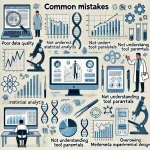
Future of Healthcare: How AI Is Revolutionizing Medicine Through Precision Health Informatics
November 30, 2023I. The Convergence of AI and Health Informatics
A. Expansion of Health Information Systems 1. Integrated Data Ecosystem: – Health informatics, empowered by AI, contributes to the expansion of integrated health information systems. – AI enables the seamless integration of diverse healthcare data sources, including electronic health records (EHRs), medical imaging, and wearable device data.
2. *Interoperability Enhancement:*
- AI technologies facilitate interoperability between different health information systems.
- Improved interoperability ensures that healthcare providers have access to a comprehensive view of patient data, leading to more informed decision-making. 3. *Population Health Management:*
- Health informatics, supported by AI analytics, enhances population health management initiatives.
- AI-driven analytics identify population health trends, risk factors, and areas for targeted interventions, contributing to proactive healthcare strategies.
B. AI Driving Personalized Medicine 1. Genomic Data Analysis: – AI plays a pivotal role in analyzing genomic data to identify genetic variations associated with diseases and treatment responses. – Personalized medicine leverages AI to tailor treatment plans based on an individual’s genetic makeup, optimizing therapeutic outcomes.
2. *Clinical Decision Support:*
- Health informatics, integrated with AI-based clinical decision support systems, enables personalized treatment recommendations.
- AI algorithms analyze patient data, including medical history and genetic information, to guide clinicians in selecting the most effective and personalized interventions. 3. *Predictive Modeling for Disease Risk:*
- AI models contribute to predictive modeling for assessing an individual's risk of developing specific diseases.
- By analyzing various data sources, including genetic, clinical, and lifestyle data, AI-driven models help identify individuals at higher risk, enabling targeted preventive measures.
4. *Real-Time Monitoring and Adaptive Interventions:*
- AI-enabled health informatics supports real-time monitoring of patient data, facilitating adaptive interventions.
- Continuous analysis of patient data allows for dynamic adjustments to treatment plans, ensuring that interventions align with evolving health conditions.
The convergence of AI and health informatics is transforming the healthcare landscape by expanding health information systems and driving the paradigm shift towards personalized medicine. AI’s ability to analyze vast datasets, improve interoperability, and provide personalized insights empowers healthcare providers to deliver more targeted and effective care. This convergence represents a key milestone in advancing patient-centric healthcare practices.
II. AI Applications in Clinical Care
A. Risk Assessment & Precision Diagnostics 1. Predictive Risk Models: – AI applications develop predictive risk models by analyzing patient data to assess the likelihood of developing specific health conditions. – Risk assessment models aid in early detection and intervention for individuals at higher risk, improving preventive care strategies.
2. *Precision Diagnostics:*
- AI-driven diagnostic tools enhance the precision and accuracy of disease diagnosis.
- Machine learning algorithms analyze diverse datasets, including medical images and patient records, to provide more nuanced and accurate diagnostic insights. 3. *Early Detection of Diseases:*
- AI applications contribute to the early detection of diseases by analyzing biomarkers, genetic information, and clinical data.
- Early identification allows for timely interventions and personalized treatment plans, potentially improving patient outcomes.
B. Personalized Treatment Recommendations 1. Treatment Response Prediction: – AI models predict individual patient responses to different treatment options based on historical patient data. – Personalized treatment recommendations help clinicians choose interventions that are more likely to be effective for a particular patient, optimizing therapeutic outcomes.
2. *Adaptive Treatment Plans:*
- AI supports the development of adaptive treatment plans that dynamically adjust based on real-time patient data.
- Continuous monitoring allows for the modification of treatment strategies to address changes in a patient's health status and response to interventions. 3. *Genomic Medicine Integration:*
- AI applications integrate genomic data into treatment decision-making.
- By analyzing genetic information, AI helps identify genetic variations that influence drug metabolism and responses, guiding the selection of personalized treatment approaches.
C. Accelerating Drug Discovery 1. Target Identification: – AI accelerates drug discovery by identifying potential therapeutic targets through the analysis of biological and molecular data. – Target identification expedites the early stages of drug development.
2. *Drug Repurposing:*
- AI models analyze existing datasets to identify opportunities for repurposing existing drugs for new therapeutic indications.
- Drug repurposing can reduce development timelines and costs. 3. *Predictive Toxicology:*
- AI contributes to predictive toxicology assessments, identifying potential adverse effects of drug candidates early in the development process.
- Early identification of toxicological risks enhances the safety profile of new drugs.
AI applications in clinical care transform risk assessment, diagnostics, treatment recommendations, and drug discovery processes. By harnessing the power of machine learning and data analytics, AI enhances the precision and personalization of healthcare, ultimately improving patient outcomes and advancing the development of innovative therapies.
III. Optimizing Operational Intelligence
A. Automated Administrative Workflow 1. Streamlining Administrative Tasks: – AI automates routine administrative tasks, such as appointment scheduling, billing, and claims processing. – Automation of administrative workflows reduces manual efforts, minimizes errors, and enhances overall operational efficiency.
2. *Natural Language Processing (NLP):*
- AI, particularly NLP, is employed to process and understand unstructured text data in administrative documents.
- NLP applications enable the extraction of valuable information from documents, improving the accuracy of administrative processes. 3. *Optimizing Resource Allocation:*
- AI-driven tools assist in optimizing resource allocation by analyzing historical data on resource utilization.
- Predictive analytics contribute to better decision-making regarding staffing levels, equipment usage, and resource distribution.
B. Intelligent Patient Scheduling Systems 1. Personalized Appointment Scheduling: – AI-driven patient scheduling systems analyze historical appointment data and patient preferences to offer personalized scheduling options. – Personalized scheduling enhances patient satisfaction and reduces appointment no-show rates.
2. *Real-Time Adjustments:*
- Intelligent scheduling systems dynamically adjust appointment slots based on real-time factors, such as cancellations, delays, or urgent care needs.
- Real-time adjustments improve the efficiency of scheduling and reduce patient wait times. 3. *Resource Optimization:*
- AI optimizes the allocation of resources, including healthcare providers and equipment, within the scheduling system.
- Efficient resource allocation ensures that patient appointments are scheduled with the right provider and necessary resources.
C. Predictive Capacity Planning 1. Forecasting Patient Volumes: – AI analyzes historical data and external factors to predict patient volumes and demand for healthcare services. – Predictive capacity planning helps healthcare organizations prepare for peak periods, reducing wait times and optimizing resource utilization.
2. *Emergency Department Optimization:*
- AI contributes to optimizing emergency department operations by predicting patient arrivals and acuity levels.
- Predictive analytics aid in resource allocation, triage decisions, and overall emergency department efficiency. 3. *Supply Chain Management:*
- AI-driven capacity planning extends to supply chain management by predicting the demand for medical supplies and pharmaceuticals.
- Accurate predictions support inventory management, preventing shortages and excess stock.
Optimizing operational intelligence with AI enhances the efficiency of healthcare organizations. Automated administrative workflows, intelligent patient scheduling systems, and predictive capacity planning contribute to improved resource utilization, patient satisfaction, and overall operational performance. AI-driven insights enable healthcare providers to make data-driven decisions for more effective and responsive healthcare delivery.
IV. The Promise of Proactive & Preventive AI
A. Genome-Specific Screening & Surveillance 1. Genomic Risk Prediction: – AI analyzes individual genomic data to identify genetic variations associated with disease risk. – Genomic screening provides personalized risk assessments, allowing for proactive preventive measures based on genetic predispositions.
2. *Cancer Screening and Surveillance:*
- AI contributes to personalized cancer screening by considering genetic factors and family history.
- Surveillance systems utilize AI to monitor changes in genetic markers, enhancing early detection and intervention for individuals at higher risk. 3. *Infectious Disease Surveillance:*
- AI-enabled genomic surveillance tracks the evolution of infectious diseases by analyzing genomic sequences.
- Early identification of genetic variations in pathogens supports proactive measures for disease prevention and control.
B. Patient-Specific Early Warning Systems 1. Continuous Monitoring: – AI-driven early warning systems continuously monitor patient data, including vital signs, biomarkers, and behavioral patterns. – Real-time analysis enables the early detection of deviations from baseline health, prompting timely interventions.
2. *Predictive Analytics for Complications:*
- AI predicts the likelihood of developing complications based on individual patient data.
- Patient-specific early warning systems provide healthcare providers with alerts and recommendations for preventive actions. 3. *Chronic Disease Management:*
- AI supports personalized management of chronic diseases by monitoring key indicators and predicting exacerbations.
- Patient-specific early warning systems empower individuals and healthcare teams to proactively manage chronic conditions.
C. Context-Aware Health Recommendations 1. Lifestyle and Behavioral Analysis: – AI analyzes lifestyle and behavioral data to provide context-aware health recommendations. – Personalized recommendations consider factors such as activity levels, dietary habits, and sleep patterns for preventive health measures.
2. *Environmental Influences:*
- AI takes into account environmental factors, such as air quality and geographical location, to tailor health recommendations.
- Context-aware recommendations address health risks associated with specific environmental conditions. 3. *Integration with Wearable Devices:*
- AI seamlessly integrates with wearable devices to provide real-time, context-aware health advice.
- Wearable devices, coupled with AI, offer personalized insights to users, encouraging proactive health behaviors.
The promise of proactive and preventive AI in healthcare is realized through genome-specific screening, patient-specific early warning systems, and context-aware health recommendations. By leveraging individualized genetic information, continuous monitoring, and contextual factors, AI empowers both healthcare providers and individuals to take proactive measures for preventing diseases, managing chronic conditions, and promoting overall well-being.
V. Overcoming Barriers to Adoption
A. Clinician Training on AI Tools 1. Education and Training Programs: – Establish comprehensive education and training programs to familiarize clinicians with AI tools and their applications in healthcare. – Training should cover the use of AI for diagnosis, treatment planning, and collaborative decision-making.
2. *Integration into Medical Curricula:*
- Incorporate AI-related coursework and practical training into medical school and continuing education curricula.
- Ensure that healthcare professionals receive ongoing education on evolving AI technologies. 3. *User-Friendly Interfaces:*
- Design AI tools with user-friendly interfaces to facilitate intuitive use by clinicians.
- Provide user training sessions to increase comfort and proficiency with AI applications in daily clinical workflows.
B. Regulatory Frameworks for AI 1. Establish Clear Standards: – Collaborate with regulatory bodies to establish clear standards for the development, validation, and deployment of AI applications in healthcare. – Standards should address issues such as data privacy, algorithm transparency, and ethical considerations.
2. *Adaptive Regulations:*
- Develop adaptive regulatory frameworks that can keep pace with the rapid advancements in AI technology.
- Implement regulatory processes that ensure the safety, efficacy, and ethical use of AI tools in healthcare settings. 3. *International Collaboration:*
- Foster international collaboration to create harmonized regulatory guidelines for AI in healthcare.
- Collaborative efforts can facilitate the development of global standards, promoting interoperability and trust.
C. Public Understandability & Trust 1. Transparency and Explainability: – Emphasize transparency in AI algorithms and models, ensuring that their functioning is understandable to both clinicians and the public. – Develop mechanisms for explaining AI-driven decisions to build trust and confidence.
2. *Public Awareness Campaigns:*
- Conduct public awareness campaigns to educate the general population about the benefits and limitations of AI in healthcare.
- Address misconceptions and highlight real-world examples of successful AI applications. 3. *Inclusive Decision-Making:*
- Involve patients, advocacy groups, and the broader public in the decision-making processes related to AI adoption in healthcare.
- Solicit feedback, address concerns, and ensure that AI applications align with patient values and expectations.
Overcoming barriers to the adoption of AI in healthcare requires a multifaceted approach, addressing clinician training, regulatory frameworks, and building public understandability and trust. By investing in education, developing clear regulations, and fostering transparent communication, healthcare systems can create an environment conducive to the responsible and effective integration of AI technologies.

















